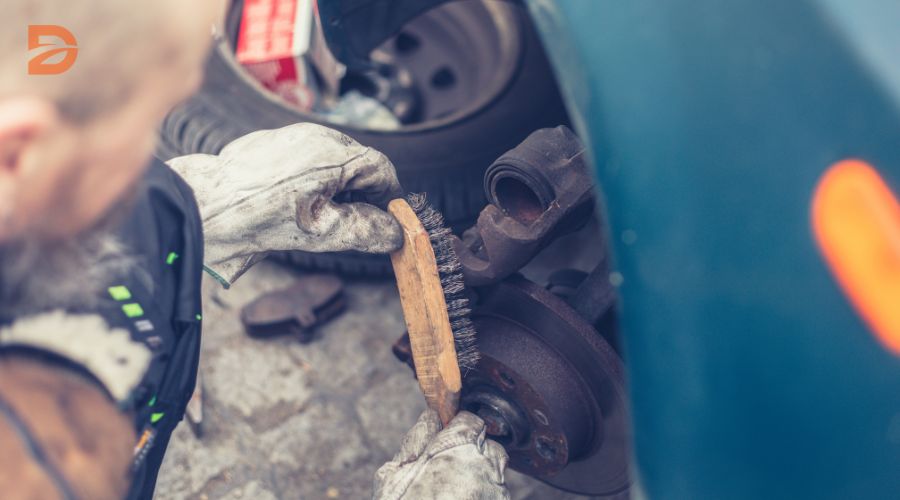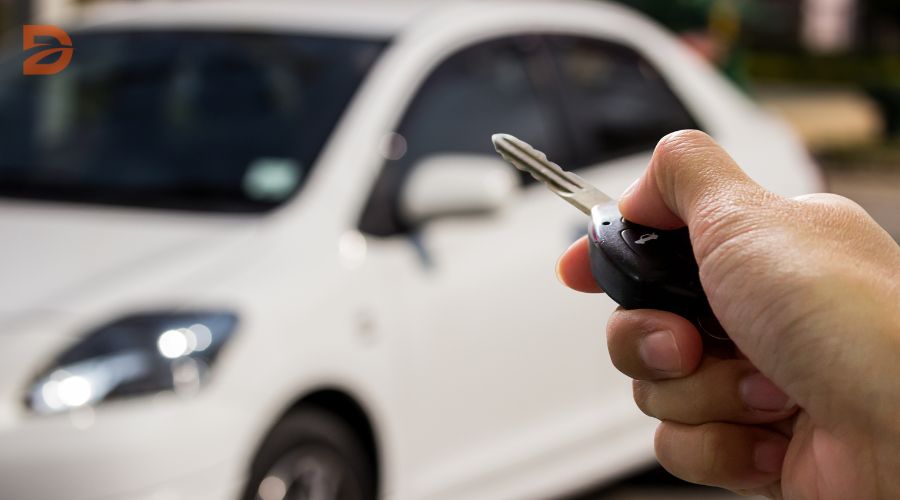Your car’s brakes are its guardian angels, silently standing between you and potential disaster every time you press the pedal. Knowing when to check and change your brake pads is crucial for safety and avoiding costly repairs. While mileage is a helpful ballpark, the lifespan of your brake pads depends on various factors, including driving habits, vehicle type, terrain, climate, and pad material. Beyond the numbers, several telltale signs scream for attention, such as screeching or grinding noises, vibrations through the steering wheel or pedal, increased braking distance, and a dashboard warning light. Regular brake pad checks every six months or 10,000 kilometers, whichever comes first, can help detect wear and tear before it becomes a critical issue.
So, when is the right time to replace your brake pads? Are you unknowingly risking your safety by driving with worn-out pads? Let’s dive in and explore the answers to these crucial questions.
Key Takeaways
- Brake pads typically last between 30,000-35,000 miles in urban use, with some exceptions.
- Pay attention to warning signs like squealing, grinding noises, or a vibrating pedal – these indicate it’s time for an inspection.
- Regular brake pad checks every six months or 10,000 kilometers can help detect wear and tear early.
- Driving habits, vehicle type, and brake pad material all affect the lifespan of your car’s brakes.
- Replacing worn brake pads is essential for safety and preventing damage to other brake components.
Understanding Brake Pad Wear and Its Impact
Brake pads are the unsung heroes of vehicle safety, responsible for bringing your car to a smooth and reliable stop. However, these vital components do not last forever. Understanding the lifecycle of brake pads is crucial for maintaining the integrity of your braking system and ensuring your safety on the road.
The Lifecycle of Brake Pads
Brake pads undergo a “break-in” period when they first meet the rotors. During this phase, it’s important to avoid hard braking or abrupt stops, as the pads need time to adjust to the rotors. After the break-in period, regular usage and driving conditions, such as city driving or off-road environments, can accelerate brake pad wear.
Signs of Wear and Tear
Recognizing the signs of brake pad wear is key to maintaining vehicle safety. Squeaking or grinding brake noise, reduced braking efficiency, and a spongy brake pedal are all indicators that it’s time to have your brakes inspected. Ignoring these warning signs can lead to more expensive repairs and, more importantly, compromised safety.
Brake pads should be inspected every 10,000 miles and replaced every 30,000 to 70,000 miles, depending on driving conditions and habits. By staying vigilant and addressing brake pad wear issues promptly, you can ensure your vehicle’s brake pad lifespan is maximized, and your driving experience remains safe and reliable.
| Symptom | Potential Issue |
|---|---|
| Grinding Brake Noise | Severely worn brake pads, possibly requiring rotor replacement |
| Squeaking Brake Noise | Brake pad wear, with the wear indicator contacting the rotor |
| Reduced Braking Efficiency | Brake pad wear or potential issues with the brake system |
| Spongy Brake Pedal | Air in the brake lines or a problem with the master cylinder |
By understanding the brake pad break-in period, recognizing the signs of brake pad wear, and staying proactive with maintenance, you can ensure your vehicle’s braking system remains in top condition, keeping you and your loved ones safe on the road.
Brake pad replacements, car brakes: Factors Influencing Wear
When it comes to maintaining your vehicle’s braking system, understanding the factors that influence brake pad wear is crucial. The lifespan of your brake pads can vary significantly depending on your driving habits, the type of driving, the material of the brake pads, and the weight of your vehicle.
Driving Habits and Conditions
Your driving style and the conditions you encounter can have a significant impact on the longevity of your brake pads. Frequent braking in heavy traffic or aggressive driving with sudden stops can accelerate the wear on your brake pads. In contrast, long-distance highway driving with minimal braking can extend the life of your brake pads.
For example, city driving with stop-and-go traffic tends to wear out brake pads faster than rural or highway driving. Factors like off-road conditions and rough terrain can also contribute to accelerated brake pad wear.
Vehicle Type and Brake Pad Material
The type of vehicle you drive and the material of your brake pads can also influence their lifespan. Heavier vehicles, such as trucks or SUVs, exert more pressure on the brakes, leading to faster brake pad wear. Similarly, performance-oriented vehicles often have high-performance brake pads that may wear out quicker than standard pads.
The composition of the brake pads also plays a role in their lifespan. Organic brake pads tend to wear out faster due to heat limitations, while semi-metallic and ceramic brake pads offer greater durability and longevity.
“Selecting the appropriate type of brake pad, whether economy, premium, or specialized for heavy loads, can impact the longevity and performance of the brake pads.”
Ultimately, the frequency of your brake pad replacements will depend on a combination of these factors. Regular inspections and monitoring of the condition of your brake pads are essential to ensuring your vehicle’s safety and optimal braking performance.
The Importance of Regular Maintenance
Maintaining your brake system is crucial for your safety and the longevity of your vehicle. Regular brake pad replacement, inspections, and timely brake fluid changes can extend the life of your brakes and ensure they perform optimally.
Identifying Early Warning Signs
Being attentive to the early signs of brake wear can help you address issues before they escalate. Some common symptoms to watch out for include:
- Squeaking or squealing noises when braking
- Grinding or vibrating sensations in the steering wheel
- Leaking brake fluid
- A soft or spongy brake pedal
- The car pulls to one side when braking
- A burning smell while driving
- The brake warning light illuminating the dashboard
Addressing these issues promptly can prevent costly repairs and ensure your brakes remain in top condition. Regular brake inspections, as recommended by your vehicle manufacturer, can help identify potential problems before they become dangerous.
“Neglecting brake maintenance can lead to brake failure, increasing the risk of accidents, from small fender benders to major incidents.”
By staying on top of your brake system maintenance, you can enjoy a safer, more reliable driving experience and extend the life of your vehicle’s braking components.
Choosing the Right Replacement Brake Pads
When it comes to brake pad replacement, selecting the right type can make a significant difference in your vehicle’s performance and comfort. Brake pads vary in their composition and design, catering to different driving needs and preferences. Whether you prioritize superior stopping power or a quieter ride, understanding the available options can help you make an informed decision.
Ceramic brake pads are known for their durability and reduced noise levels, making them a popular choice for highway and conservative driving. On the other hand, semi-metallic brake pads offer a balance between stopping power and noise, making them suitable for aggressive or mountainous driving conditions. Organic brake pads, while less expensive, are ideal for city driving where frequent stops are necessary.
| Brake Pad Type | Durability | Noise Level | Recommended Driving Conditions |
|---|---|---|---|
| Ceramic | High | Low | Highway, conservative driving |
| Semi-metallic | Moderate | Moderate | Aggressive, mountainous/towing driving |
| Organic | Low | Moderate | City driving |
When selecting brake pads, it’s essential to consider the specific needs of your vehicle and driving conditions. Consulting with a professional or researching your vehicle’s recommended brake pad specifications can help ensure you choose the right replacement that offers the optimal balance of performance, durability, and comfort.
Conclusion
Maintaining your car’s brakes is a crucial aspect of vehicle safety and longevity. By understanding the recommended replacement intervals for brake pads and rotors, as well as the common signs of wear and tear, you can stay proactive in ensuring your brakes are always in top condition.
Regular brake pad maintenance, coupled with prompt attention to any issues, can help extend the life of your braking system and prevent costly repairs down the line. Whether your vehicle is a Hyundai Elantra or any other make and model, staying vigilant about brake system inspection and brake service is essential for your safety and the safety of your passengers.
Remember, your brakes are your lifeline on the road. By prioritizing brake pad replacement when needed and addressing any warning signs, you can drive with confidence, knowing that your vehicle’s braking performance is optimized for a smooth and secure journey, mile after mile.
FAQ
When should I replace my brake pads?
Brake pads should be inspected every 10,000 miles and replaced every 30,000 to 70,000 miles, depending on driving conditions and habits.
How do I know if my brake pads need to be replaced?
Several signs indicate it’s time to replace your brake pads, including screeching or grinding noises, vibrations through the steering wheel or pedal, increased braking distance, and a dashboard warning light.
What factors influence the lifespan of my brake pads?
The lifespan of your brake pads depends on various factors, including driving habits, vehicle type, terrain, climate, and pad material. City driving, off-road conditions, and heavier vehicles tend to wear out brake pads faster.
How can I extend the life of my brake pads?
Proper maintenance, such as regular brake inspections, addressing any unusual noises or reduced braking efficiency promptly, and embracing smart driving habits like easing off the brakes, can significantly extend the life of your brake pads.
How do I choose the right replacement brake pads for my vehicle?
Brake pads vary in composition and design, catering to different driving needs and preferences. Researching and choosing the right type of brake pad for your driving conditions and vehicle specifications ensures that you get the best performance and value.










